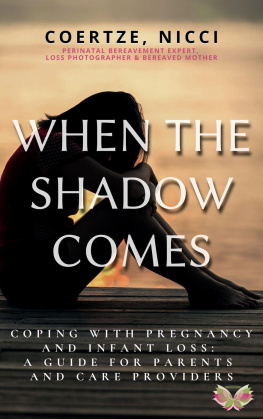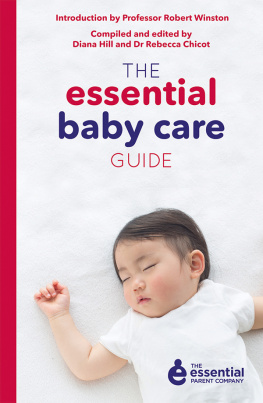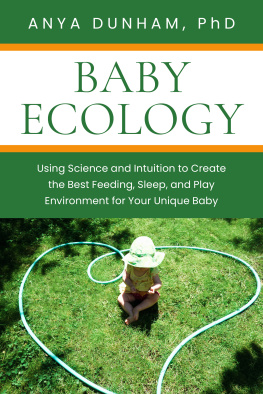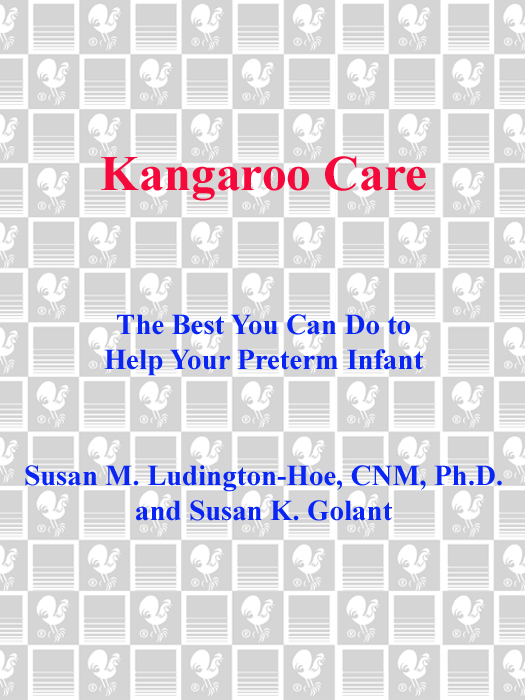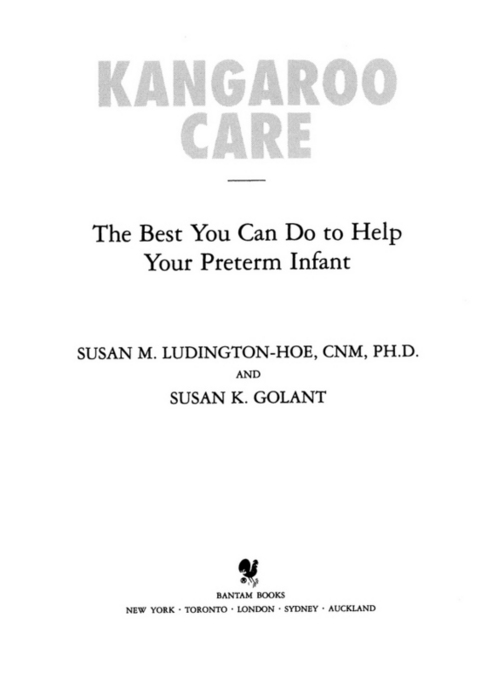WHAT PROFESSIONALS ARE SAYING
ABOUT KANGAROO CARE
Given the powerful information within these covers, parents are empowered to practice the nurturing that is innate and a part of our cultural experience of being human. Kangaroo Care is a must read for expectant and newly delivered parents and health professionals that offer special infant care.
Chandice Covington, Ph.D., R.N.C., P.N.P.
Wayne State University College of Nursing
The authors have done a great and important job in researching and writing about Kangaroo Care.
Elisabeth Bing, F.A.C.C.E.
author of Six Practical Lessons for an Easier Childbirth
Kangaroo Care not only speeds and enhances the recovery of preterm infants, it can empower parents, reduce anxiety and strengthen the emotional and spiritual bond between parents and their babies.
Vimala McClure author of Infant Massage: A Handbook for Loving Parents founder, International Association of Infant Massage Instructors
WHAT MOTHERS ARE SAYING
During Kangaroo Care, I felt very calm and relaxed. It felt so comforting to have Cindy on my chest. It felt very natural. Besides the effect it was having on her, it was most therapeutic for me!
I feel more familiar with my baby now. I can handle her now without the fear of dropping or hurting her. I feel more at ease about positioning her to breastfeed. Im even more excited about her coming home.
It was so nice to be able to hold him and know that he likes to be held by his mommy. Just to be able to smell his hairit was great!
AND FATHERS TOO!
Much of my worry regarding my ability to handle him has dissipated. It was a very enjoyable experience, and I actually feel closer to him.
This gave me so much joy. I have never felt so much happiness.
Kangaroo Care
A Bantam Book/October 1993
All rights reserved.
Copyright 1993 by Susan M. Ludington-Hoe and Susan K. Golant
Foreword copyright 1993 by Anthony J. Hadeed, M.D.
No part of this book may be reproduced or transmitted in any form or by any means, electronic or mechanical, including photocopying, recording, or by any information storage and retrieval system, without permission in writing from the publisher. For information address: Bantam Books.
Library of Congress Cataloging-in-Publication Data
Ludington-Hoe, Susan.
Kangaroo care : the best you can do to help your preterm infant / Susan M. Ludington-Hoe and Susan K. Golant.
p. cm.
eISBN: 978-0-307-81338-1
1. Infants (Premature)Care. 2. TouchTherapeutic use.
3. Parent and infant. I. Golant, Susan K. II. Title.
RJ250.L75 1993 93-8485
618.922011dc20
Bantam Books are published by Bantam Books, a division of Bantam Doubleday Dell Publishing Group, Inc. Its trademark, consisting of the words Bantam Books and the portrayal of a rooster, is Registered in U.S. Patent and Trademark Office and in other countries. Marca Registrada. Bantam Books, 1540 Broadway, New York, New York 10036.
v3.1
Contents
Foreword
Until recently, health professionals have discouraged parents from holding their preterm infantsthe risk of harm and infection to these sensitive and fragile beings was too great.
Kangaroo Care, a program of skin-to-skin contact between parent and child, is part of the revolution in the care of premature infants. First researched in Latin America, Kangaroo Care was tested around the world during the 1980s, and it is quickly becoming a popular alternative for the treatment of premature infants. Neonatologists like myself are seeing great improvements in newborns who participate in Kangaroo Care. Not only do the sleeping and breathing patterns of premature infants improve, the babies appear to relax and become content from the touch of their parents skin. Parents also benefit psychologically because they are allowed to play an active rather than a passive role in the recovery of their infant.
There is a need for high-technology intervention to help premature infants, but parents and babies are starving for one anothers touch. As a neonatologist, I feel comfortable encouraging parents to use Kangaroo Care; it has been a positive experience for all of the babies (and parents) I have worked with and studied.
Susan Ludington-Hoe and Susan Golant have written a thorough, well-researched, and thoughtful guide to Kangaroo Care. The authors cover all aspects of the programincluding its history, research basis, and practiceso that parents can make an informed choice to kangaroo their baby. I highly recommend this clear, step-by-step manual to any parent faced with the challenge of caring for a preterm infant.
Anthony L. Hadeed, M.D.
Director, Neonatal Intensive Care Unit
Kadlec Medical Center
PART ONE
What Is
Kangaroo Care?
Todays Revolution in
Premature Care
A tiny premature baby was born 16 weeks early (24 weeks gestation) at Brigham and Womens Hospital in Boston, Massachusetts, in October 1991. Steven was quite sick, and the medical staff had great difficulty keeping him alive. It appeared that all the treatments they tried were ineffective. Sadly, Steven was slipping away: his blood values were dropping, and his immature lungs were unable to provide him with enough oxygen.
Under the direction of the nurses in the neonatal intensive care unit (the NICU), Steven was given to his mother, Dorothy, so she would have a chance to say good-bye. They left mother and baby alone and returned two hours later.
What a surprise awaited them upon their return! Dorothy was still holding Steven, who was still connected to all his equipment and monitors. But she had undressed him and had spontaneously placed him on her bare chest. When the nurse in charge took Stevens vital signs for what she thought was the last time, she noticed the level of oxygen in his blood had increased, the level of carbon dioxide had dropped (as one would want it to), his blood pressure was more stable, his breathing less labored.
The nurses contacted the resident, and together they asked Dorothy to continue holding her baby throughout the night so that they could monitor his progress. Within twenty-four hours, Steven improved dramatically. When Dorothy grew tired, her husband Jack came in and took over holding their infant. Over the course of the next two days, Steven was continuously held in the intensive care nursery of this teaching hospital.
During those three days, Stevens physiological condition reversed. The health care staff continued doing everything possible to save his life. Dorothy and Jack were exhausted from their round-the-clock vigil, and the neonatologist suggested they reduce their holding to three hours a day. In the following weeks, they alternated evenings with each other, until Steven was taken out of the incubator and placed in an open-air crib. He was discharged from the hospital at four months of age. Several months later, Steven and his parents appeared on Good Morning Americaa miracle baby and his family.
Heartened by this success, the health staff were eager to try holding with other premature infants. Soon babies whose breathing was regulated by ventilators were being placed on their parents chests. By a happy accident, Dorothy and Steven had demonstrated the enormous benefits of Kangaroo Care.


